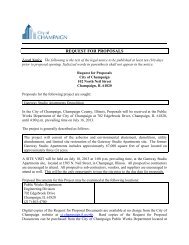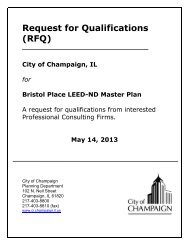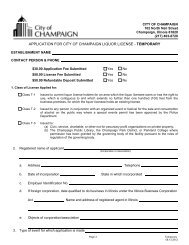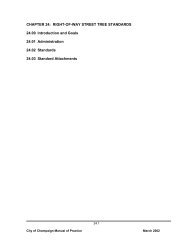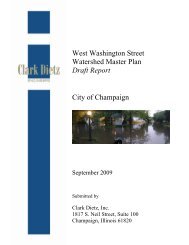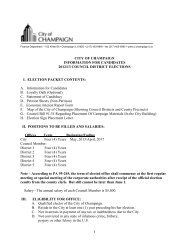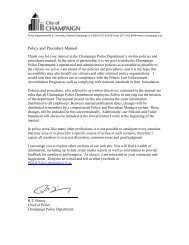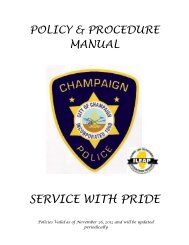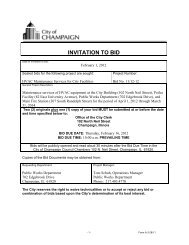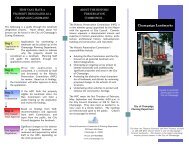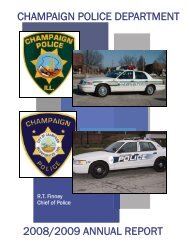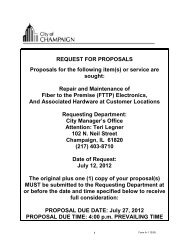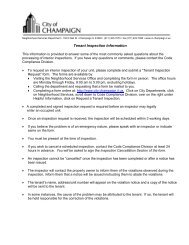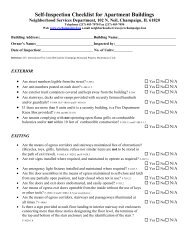2010-2014 Consolidated Plan - City of Champaign
2010-2014 Consolidated Plan - City of Champaign
2010-2014 Consolidated Plan - City of Champaign
You also want an ePaper? Increase the reach of your titles
YUMPU automatically turns print PDFs into web optimized ePapers that Google loves.
Neighborhood Wellness DefinedIn 1992, the <strong>Champaign</strong> <strong>City</strong> Council adopted the Neighborhood Wellness Action <strong>Plan</strong>. The NeighborhoodWellness Action <strong>Plan</strong> defines neighborhood wellness as an objective for all neighborhoods in the <strong>City</strong>.The <strong>Plan</strong> states that neighborhood wellness is a state <strong>of</strong> livability wherein housing is decent, safe, andaffordable; private yards and public spaces are well maintained; crime is low; streets and other publicfacilities are in sound condition; and residents are active in neighborhoods affairs. It also refers to anenvironment supportive <strong>of</strong> both public and private investments and one in which property values areprotected and neighborhood character is preserved. The concept <strong>of</strong> neighborhood wellness also meansthe following:• Citizen cooperation with local government in improving neighborhoods• Earlier detection and elimination <strong>of</strong> conditions which cause neighborhood deterioration and residentdissatisfaction• Neighborhood-oriented service delivery based on the needs and priorities <strong>of</strong> individual neighborhoodsto better manage and monitor neighborhood improvementsThe concept <strong>of</strong> neighborhood wellness is important because it presents a comprehensive strategy whichaddresses issues facing individual neighborhoods. The Neighborhood Analysis Report is the documentthat measures various indicators to determine areas’ specific issues and services demands.HistoryThe concept <strong>of</strong> neighborhood wellness dates back to 1985. Prior to 1985, the <strong>City</strong> <strong>of</strong> <strong>Champaign</strong> hadconcentrated its housing rehabilitation programs, intensive code enforcement, and CommunityDevelopment Block Grant (CDBG)-funded capital improvements almost exclusively in the northeastsection <strong>of</strong> the <strong>City</strong>. Neighborhoods that experienced extensive deterioration were targeted for massiveclearance, funded with federal and state grants. By 1985, grants for clearance projects were no longeravailable. It was intended that through a citywide neighborhood wellness program, the <strong>City</strong> would beable to attack blight and decline at earlier stages to prevent the need for clearance and redevelopment.Therefore, in 1985, the <strong>City</strong> Council directed staff to expand community development activities citywide.This directive recognized that blight and neighborhood decline existed outside <strong>of</strong> the areas traditionallydesignated as community development target neighborhoods.In 1992, the <strong>City</strong> Council adopted the Neighborhood Wellness Action <strong>Plan</strong> as an element <strong>of</strong> the <strong>City</strong>’sComprehensive <strong>Plan</strong>, identifying the strategies to be used to deliver neighborhood-based servicesthroughout the <strong>City</strong>. The document was later awarded a National <strong>Plan</strong>ning Award from the American<strong>Plan</strong>ning Association. The strategies included in the <strong>Plan</strong> were based on the needs identified in the 1990Neighborhood Analysis Report. Strategies were targeted in five primary areas: housing, propertymaintenance, crime/public safety, infrastructure, and citizen involvement. Over the past ten years, this<strong>Plan</strong> has served as the foundation <strong>of</strong> the <strong>City</strong>’s philosophy to target <strong>City</strong> services at the neighborhoodlevel, customizing problem-solving strategies to the unique needs <strong>of</strong> each area. Annual reports arecreated to review the past year’s accomplishments based on the policy direction from the <strong>Plan</strong>.Update ProcessThe 2003 Neighborhood Wellness <strong>Plan</strong> update process has four main steps. The first step, theNeighborhood Classification System, provides a foundation for analyzing data by individual planning areasand a basis for developing program strategies. The Neighborhood Analysis Report which outlines theconditions in each planning area is the second step <strong>of</strong> the process. The third step involves publicparticipation to determine the priorities <strong>of</strong> residents in each neighborhood, define the role <strong>of</strong> residents inthe wellness program, and identify methods to encourage the establishment <strong>of</strong> neighborhood-basedNeeds Assessment: Non-Housing Community Development 67



